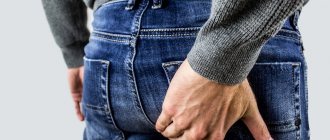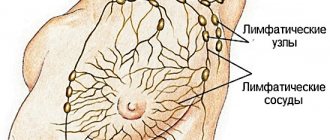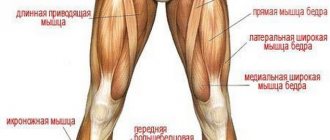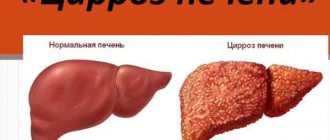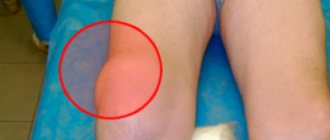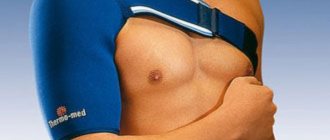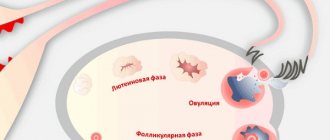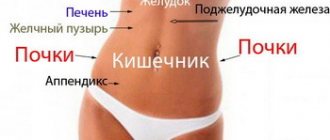What diseases may indicate pain in the buttocks?
If your lower body begins to remind itself unpleasantly, you should start diagnosing it by visiting a neurologist. In 70% of cases, problems in the hip and buttocks are associated with the condition of the spine. At the appointment, the neurologist will be able to collect data on the nature of the pain and conduct a neurological examination. During the initial appointment, the doctor will be able to guess whether the pain in the buttock is neurological in nature or whether the source of the pathology is the joints, and a consultation with an orthopedist is necessary. In addition, pain in the lower back and buttocks can be caused by kidney pathologies, and then the patient needs to be redirected to a nephrologist. In diagnosing the causes of pain in the buttocks, the nature of the pain plays an important role. Therefore, before your consultation, try to observe how and when your pain syndrome manifests itself:
- Do you feel pain at rest or when moving or sitting?
- What is the nature of the pain: acute, sharp, aching, pulling, dull, constant, spontaneous, passing, radiating from the back?
- In which part of the buttock does it appear: thigh, right or left buttock?
- Does the pain affect only the buttock or spread to the leg?
The most common causes of pain in the buttocks can be:
- degenerative changes in the lumbosacral spine (osteochondrosis, herniated disc, pinched sciatic nerve);
- inflammation of the piriformis muscle;
- spinal canal stenosis. A complex of degenerative changes in the spine can lead to a narrowing of the spinal canal in the lumbar region or lateral recess. This condition is often referred to as “spondylosis.” One of its forms of manifestation is pain radiating to the muscles of the buttocks;
- pathology of the sacroiliac joint;
- osteoarthritis or arthritis of the hip joints;
- kidney pathologies.
Symptoms
As a rule, with lumbar ischialgia, symptoms occur on one side, and the pain starts from the lower back and goes down the back of the thigh down to the foot.
- Pain in the lower back is usually less intense than in the leg.
- Pain, as a rule, on one side of the lower back with irradiation into the buttock or thigh along the sciatic nerve - along the back of the thigh, lower leg and foot.
- The pain decreases when the patient lies down and when walking and intensifies when standing or sitting.
- The pain is acute and burning in nature.
- Some patients may describe a feeling of tingling, numbness, or weakness in the leg.
- Weakness or numbness when moving your leg.
- Severe or shooting pain in the leg that may make it difficult to stand or walk.
- Depending on the location of the effect on the sciatic nerve, pain may also occur in the foot and toes.
Symptoms of lumbar ischialgia depend on where the root compression occurs.
For example:
- L4 root - Symptoms will usually appear on the hip. Patients may experience weakness when straightening the leg and possibly a decreased knee reflex.
- L5 root – symptoms may occur in the big toe and ankle. Patients may feel pain or numbness in the top of the foot (between the big and second toe).
- S1 root – symptoms may appear on the outer part of the foot, radiating to the toes and little toe. Patients may experience weakness when lifting the foot or trying to stand on tiptoes. There may also be decreased ankle reflexes.
When several roots are compressed, a combination of symptoms is possible.
There are a number of symptoms that deserve special attention, as they require emergency medical attention, sometimes even surgical intervention. These symptoms are:
- Symptoms that continue to worsen rather than improve may indicate possible nerve damage, especially if neurological symptoms have progressed (eg, weakness in the leg).
- Symptoms of lumbar ischialgia occur in both legs and there are signs of bowel or bladder dysfunction, which may be a sign of cauda equina syndrome. For cauda equina syndrome, emergency surgery is indicated.
If you have these symptoms, you should immediately seek medical help.
Causes of pain in the buttock radiating to the leg
The causes of pain in the thigh and buttock, radiating to the leg, can be:
- inflammatory process (post-injection abscess);
- the consequences of numerous intramuscular injections into this area;
- sciatica - pinched sciatic nerve;
- radiculopathy with radicular syndrome;
- osteoarthritis of the hip joints with osteomalacia;
- arthritis of the hip joints;
- piriformis myositis or piriformis syndrome;
- traumatic injury in the hip joint, lumbosacral spine, coccyx.
Methods of pain relief
The best way to relieve pain and swelling is by injection of the following types of drugs:
- non-steroidal anti-inflammatory drugs;
- muscle relaxants that promote muscle relaxation;
- analgesics with anti-inflammatory effects;
- B vitamins;
- chondroprotectors;
- combined painkillers.
Folk remedies can be used to relieve pain, but only after prior consultation with a doctor.
Causes of pain in the buttock when walking
Pain when walking that appears in the buttock may be a consequence of exacerbation of osteochondrosis in the lumbar spine, especially if there is pressure from pathological structures on the nerve root. Exacerbation often occurs during the process of hernia formation, sciatica or piriformis syndrome. The same reasons can cause pain in the buttocks when sitting.
| Service | Price | Price | Promotion Price |
| Appointment with a therapist | primary 1800 rub. | repeat 1500 rub. | |
| Neurologist appointment | primary 1800 rub. | repeat 1500 rub. | free after MRI of the spine |
| Orthopedist appointment | primary 1800 rub. | repeat 1500 rub. | free after MRI of the joint |
| Consultation with an acupuncturist | primary 1800 rub. | repeat 1500 rub. | free after MRI of the spine |
| Vertebrologist consultation | primary 2000 rub. | repeat 1800 rub. | |
| Consultation with a chiropractor/osteopath | primary 2000 rub. |
| Service | Price according to Price | Discount | Discount |
| Plasma therapy of the spine or joint | 1 session 4000 rub. free doctor's appointment | 3 sessions 10,500 rub. free doctor's appointment | 5 sessions 17,500 rub. free doctor's appointment |
| Phonophoresis / Ultrasound therapy procedure (UT) | 1 session 400 rub. | 5 sessions 1575 rub. | 10 sessions 3000 rub. |
| Autohemotherapy | 450 rub. | 5 sessions 2000 rub. | 10 sessions 4000 rub. |
| Novocaine therapeutic blockade | 1500 rub. | ||
| Therapeutic paravertebral blockade | 1500 rub. | ||
| The blockade is therapeutic and medicinal, complex (use of several drugs) | 2000 rub. | ||
| Therapeutic intra-articular blockade with diprospan | 2500 rub. | ||
| Intra-articular injection of hyaluronic acid (without the cost of the drug) | 2000 rub. | ||
| Pharmacocupuncture session (drug at the discretion of the doctor) | 2100 rub. | ||
| Pharmacocupuncture session (without the cost of the drug) | 1500 rub. | ||
| Classic acupuncture session | 1200 rub. | ||
| Complex acupuncture session | 2000 rub. | ||
| Manual therapy session | 2000 rub. |
| Service | Price according to Price | Discount | Discount |
| Intravenous therapy | 800 rub. | 5 sessions 3375 rub. free doctor's appointment | 10 sessions 6750 rub. free doctor's appointment |
| Vitamin therapy (10 injections) | 4000 rub. free doctor's appointment | 3000 rub. free doctor's appointment | 3000 rub. free doctor's appointment |
| Injections (Vitamins B12) | 800 rub. | 800 rub. | 800 rub. |
| Intravenous administration of drugs | 450 rub. | 5 sessions 2140 rub. | 10 sessions 4050 rub. |
| Intravenous drip administration of drugs | 800 rub. | 5 sessions 3375 rub. | 10 sessions 6750 rub. |
| Subcutaneous/intradermal administration of drugs | 250 rub. | 5 sessions 1180 rub. | 10 sessions 2250 rub. |
| Intramuscular administration of drugs | 300 rub. | 5 sessions 1430 rub. | 10 sessions 2700 rub. |
| Autohemotherapy | 450 rub. | 5 sessions 2000 rub. | 10 sessions 4000 rub. |
Diagnosis and treatment of pain in the butt
The treatment process for pain in the buttocks depends entirely on the nature of the pathology. The patient needs to see a proctologist and attend an initial consultation. The doctor will examine the affected organ and perform palpation. If purulent discharge, bleeding and infectious processes are detected, then we suggest performing an operation to remove anal fissures.
For pain in the butt resulting from an injury, the patient is prescribed painkillers and warming ointments that can relieve swelling. Non-steroidal medications relieve pain and promote rapid healing of soft tissues.
For boils, patients are prescribed Vishnevsky ointment and ichthyol ointment. In untreated cases, medical workers use massages, warm compresses, and physical therapy.
After consulting a doctor, the patient begins to engage in physical therapy. Improves muscle tone and strengthens. Doctors at the private clinic “KDS Clinic” have developed a special gymnastic system that will relax injured muscles and reduce pain.
Effective treatment for pain in the buttocks
A correct diagnosis is the key to a quick recovery. Therefore, if you have pain in the buttocks, doctors strongly advise you to consult a doctor. If you do not have any chronic kidney disease or previously identified pathologies of the hip joint, you should begin your examination by visiting a neurologist. People with diseased kidneys who experience pain in the lower back and buttocks should urgently make an appointment with a nephrologist. For a patient who has previously been diagnosed with hip pathologies, it is best to first consult with an orthopedist, and if he does not identify any connection with the condition of the joints and pain in the buttocks, make an appointment with a neurologist. Since quite often disorders in the structures of the spine, sacroiliac joint or hip joint are to blame for pain in the buttocks, an orthopedist and neurologist, after examination, can direct the patient to undergo a tomography of the desired area of the body in order to make an accurate diagnosis:
- MRI of the lumbosacral region.
- MRI of soft tissues of the buttocks and sciatic nerve.
- MRI of the sacroiliac joint.
- MRI of the hip joints.
If a diagnosis of “post-injection abscess” is made, the patient will undergo surgical treatment - opening, removing inflammation, and then medical treatment with antibacterial drugs. In the case of piriformis syndrome, muscle relaxants and non-steroidal anti-inflammatory drugs will most likely be prescribed. In case of diseases of the spine or joints, the patient will be prescribed anti-inflammatory drugs to relieve pain in the buttocks.
Treatment of pathology of the sacroiliac joint causes certain difficulties for doctors. Despite the fact that large vessels of the superior and inferior gluteal arteries pass around the joint, its vascularization is quite weak, so all intravenous drugs or intramuscular injections for the treatment of pain do not penetrate into the joint quite well. Therefore, in this situation, the use of physiotherapy and manual therapy, the administration of corticosteroids using ultraphonophoresis, and magnetic therapy for 10-15 sessions are more effective as treatment. Sometimes a quick method of relieving severe pain in the buttocks due to a neurological disease is a drug blockade. Typically, patients note regression of pain the next day after the procedure or already on the day of the procedure. However, it should be remembered that drug blockade is a pain-relieving method, after which it is necessary to carry out a course of adequate treatment to eradicate the main cause of pain in the buttocks. Otherwise, the risk that the pain will return is very high.
Author: Shogenov Ramish Kurbanovich
Neurologist with 10 years of experience
When should you immediately consult a doctor?
Chronic compartment syndrome requires immediate attention and proper first aid. Also, at the first suspicion of diseases of the joints or circulatory system of the groin, it is worth getting diagnosed as soon as possible, because most diseases are treated only at an early stage.
Immediate help may not be needed for mild dermatological diseases, but consulting a doctor in any case will facilitate and speed up the healing process.
Reviews
10/05/2017 I chose the RIORIT center near the Ozerki metro station solely because of the discounts.
Well, I don’t have the amount that central clinics ask for to do an MRI. And it had to be done urgently. I have two children in my arms, and at the age of 30 I began to feel like an old wreck. My hands are shaking, my vision periodically gets dark, and I started talking. In this state, I am neither a mother nor an employee. So thanks to the guys for helping out. And they made an appointment for me at a convenient time, almost out of turn, and treated me with understanding and conducted a high-quality examination. Now I am undergoing plasma therapy treatment, there is progress. Thank you very much for your help. Karapityan
01/15/2018 I am very grateful to all the employees for their attentive attitude towards people and the qualifications of a neurologist.
Povozhilova
04/01/2019 I would like to say a huge thank you to the RIORIT center for their good attitude, responsiveness, and help.
Thanks to all the staff and especially orthopedist Usenko. Svetlana Anatolyevna
07/15/2019 I would like to express my deep gratitude to the doctors of the clinic!
Usenko Nikita Sergeevich is a unique doctor, he explained everything and gave advice on further restoration of the joint. There should be more doctors like this!!!! And also many thanks to Bondar T. and Abramov S. for making the correct diagnoses, which they could not do at the hospital on the Vavilovs. I will recommend your center and will also use your services myself. THANK YOU!!!!! Lidia Anatolyevna
Read all reviews
Recommended Treatments
Treatment of pain in this pathology is aimed at identifying the cause that causes it. After relieving an attack of acute pain, it is necessary to normalize blood circulation. The following methods are used in treatment:
- physiotherapeutic procedures;
- performing therapeutic exercises;
- massotherapy;
- warming procedures and compresses;
- rubbing the affected area with ointments.
Proper nutrition plays an important role in complex treatment. Spicy, salty and fatty foods, which lead to stagnation in the body, are excluded from the diet. Food should be rich in vitamins and beneficial minerals.
The patient is recommended to exercise moderately and play sports, such as swimming, jogging, cycling.
To prevent new attacks of pain, the following rules should be followed:
- avoid heavy loads, overwork and heavy lifting;
- avoid hypothermia of the back and lower back;
- sleep on a hard surface;
- persons working in an office should periodically do physical exercises;
- prevent obesity;
- give preference to foods high in calcium.
